Rocky Mountain wood tick
Dermacentor andersoni
Identification
This tick has a similar appearance to the American dog tick, but it’s distinguishable by its bright red body, which is shaped like a teardrop. Females have a white-colored shield. Males have gray and white spots on their body.9

Nymph
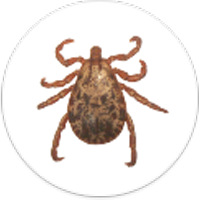
Male
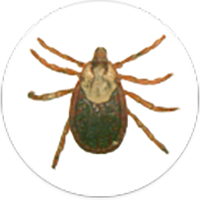
Female
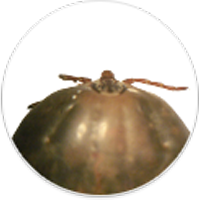
Engorged Female
Approximate Distribution
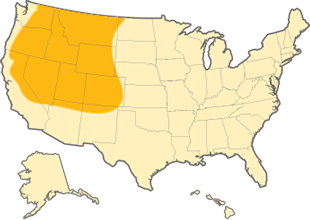
As the name suggests, the Rocky Mountain wood tick is found in the Rocky Mountain states in an area from eastern California to eastern Colorado and north to the Canadian border.10
Hosts

The Rocky Mountain wood tick is a three-host tick, meaning its preferred host depends on the stage of its life cycle. Larvae and nymphs feed on small mammals like voles, mice, and squirrels. Adults prefer larger mammals like raccoons, dogs, white-tailed deer, and cattle.11
Habitat
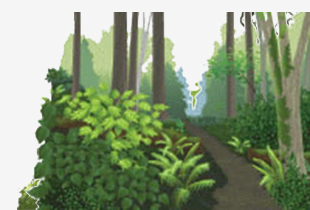
Rocky Mountain wood ticks are found in grasslands, shrublands, lightly wooded areas, and along trails.12
Diseases associated with Dermacentor andersoni20, 21
Rickettsiosis (spotted fever group)
Spotted fever group Rickettsiosisis a group of diseases caused by various species of the Rickettsia bacteria. They can affect both cats and dogs, though cats generally show no symptoms and may have been infected by contact with fleas, not ticks.38, 39
Clinical Signs
In dogs:38
● Fever
● Loss of appetite
● Swollen lymph nodes
● Painful joints
● Coughing
● Vomiting
● Diarrhea
● Swelling of face or extremities
Diagnosis and testing
To diagnose a dog, your veterinarian will likely use a combination of observing the signs and conducting blood and laboratory testing.38
Treatment
Treatment typically involves the use of the antibiotic doxycycline. In addition to medication, your pet may receive supportive care and careful monitoring to help manage symptoms and ensure well-being.38
References:
38. Rocky Mountain Spotted Fever in Dogs. Merck Vet Manual. https://www.merckvetmanual.com/generalized-conditions/rickettsial-diseases/rocky-mountain-spotted-fever-in-dogs
39. Flea-borne Rickettsiosis. Companion Animal Parasite Council. https://capcvet.org/guidelines/flea-borne-rickettsiosis/
Tick paralysis
Tick paralysis is caused by the exposure to neurotoxin released by a tick’s salivary glands when it bites. It’s a severe and potentially fatal condition that requires immediate veterinary attention. Both dogs and cats can be affected. Signs typically appear between three and nine days after the tick attaches, depending on the tick species.43
Clinical Signs
In dogs and cats:43
● Change or loss of voice
● Lack of coordination in hind legs
● Changes in breathing rate and effort
● Gagging
● Coughing
● Vomiting
● Dilated pupils
Diagnosis and testing
Diagnosis is primarily based on the presence of a tick and the observation of clinical signs. Specific laboratory tests are not typically available for tick paralysis.43
Treatment
Treating tick paralysis involves several crucial steps. First and foremost is the removal of the attached tick. Supportive care, such as IV fluids and respiratory support, is also important, as is reducing anxiety and stress in your pet.43
References:
43. Tick Paralysis in Animals. Merck Vet Manual. https://www.merckvetmanual.com/nervous-system/tick-paralysis/tick-paralysis-in-animals
Tularemia
Tularemia, sometimes called rabbit fever, is a disease caused by the bacteria Francisella tularensis. It’s aserious condition that affects both dogs and cats. Even with early diagnosis and treatment, the death rate among cats with tularemia is high. In dogs, early treatment is crucial to prevent death, and in some cases, prolonged treatment may be necessary.44, 45
Clinical Signs
In cats and dogs:44, 45
● Sudden high fever
● Swollen glands
● Decreased energy
● Loss of appetite
Some cats may show no signs of the disease, while others may become very ill.45
Diagnosis and testing
Diagnosis involves blood tests to detect antibodies that indicate the presence of the bacteria.46
Treatment
Treatment typically involves the antibiotics streptomycin, gentamicin, and tetracycline.46 In dogs, early treatment is essential to prevent death, and some dogs may require prolonged treatment, depending on the severity of the infection.44
References:
44. Tularemia (Rabbit Fever) in Dogs. Merck Vet Manual. https://www.merckvetmanual.com/dog-owners/disorders-affecting-multiple-body-systems-of-dogs/tularemia-rabbit-fever-in-dogs
45. Tularemia in Cats. Merck Vet Manual. https://www.merckvetmanual.com/cat-owners/disorders-affecting-multiple-body-systems-of-cats/tularemia-in-cats
46. Tularemia in Animals. Merck Vet Manual. https://www.merckvetmanual.com/generalized-conditions/tularemia/tularemia-in-animals
References:
9. Rocky Mountain Wood Tick. Tick Research Lab of Pennsylvania. https://www.ticklab.org/rocky-mountain-wood-tick
10. Approximate Distribution of the Rocky Mountain Wood Tick. Centers for Disease Control. https://www.cdc.gov/ticks/maps/rocky_mountain_wood_tick.pdf
11. Interspecific Differences in the Questing Behaviour of Dermacentor Andersoni and Dermacentor Variabilis (Acari: Ixodidae) larvae. The Canadian Entomologist. https://www.cambridge.org/core/journals/canadian-entomologist/article/interspecific-differences-in-the-questing-behaviour-of-dermacentor-andersoni-and-dermacentor-variabilis-acari-ixodidae-larvae/B23379F523B9B7F2A319D3957D6FDFE0
12. Rocky Mountain Wood Tick. University of Rhode Island. https://web.uri.edu/tickencounter/species/rocky-mountain-wood-tick/
20. Ticks. Companion Animal Parasite Council. https://capcvet.org/guidelines/ticks/
21. Ticks. Companion Animal Parasite Council. https://capcvet.org/guidelines/ticks/

 Austria
Austria Belgium
Belgium Czech Republic
Czech Republic Denmark
Denmark Europe
Europe Finland
Finland France
France Germany
Germany Greece
Greece Hungary
Hungary Ireland
Ireland Israel
Israel Italy
Italy Netherlands
Netherlands Norway
Norway Poland
Poland Portugal
Portugal Romania
Romania Spain
Spain Sweden
Sweden Turkey
Turkey United Kingdom
United Kingdom United States
United States